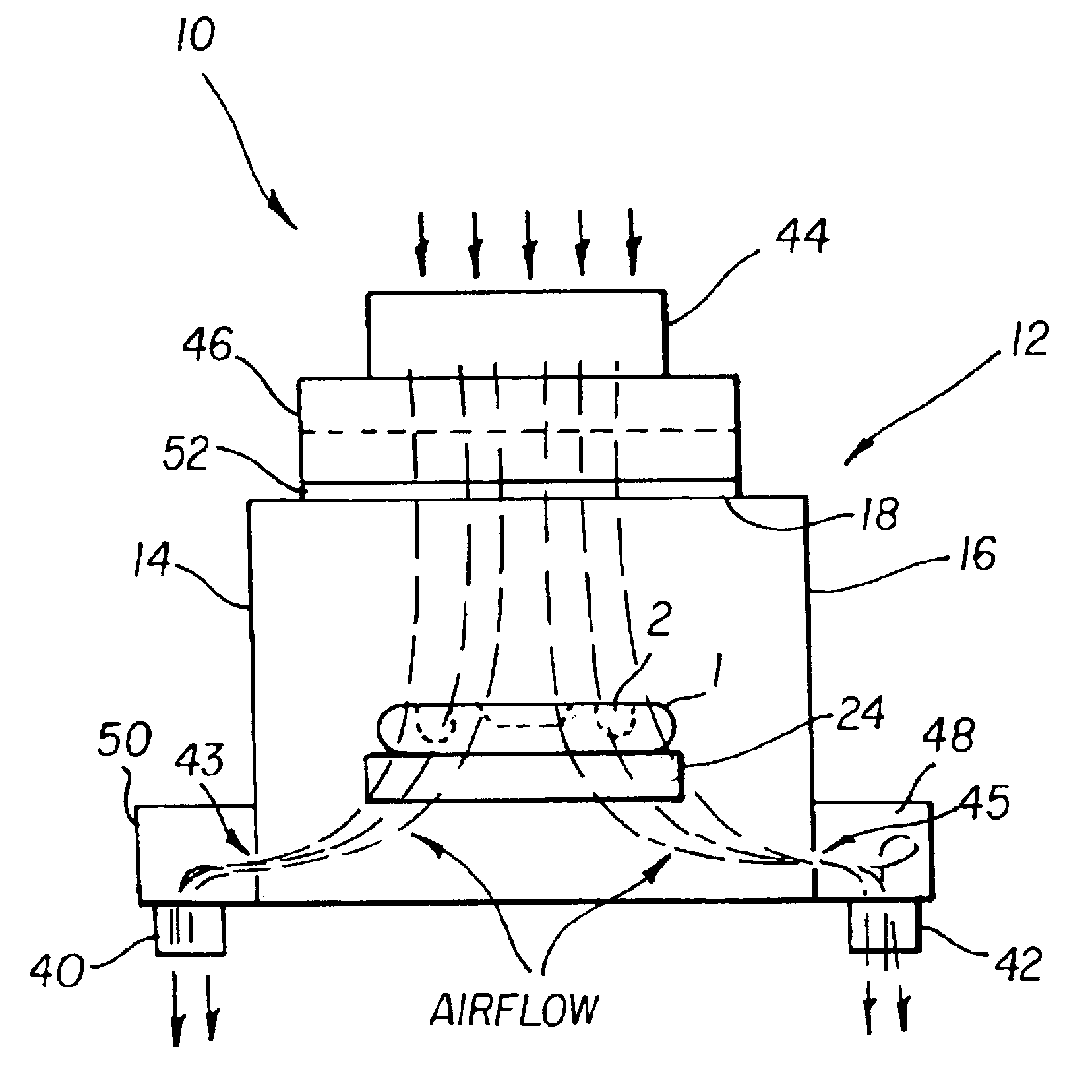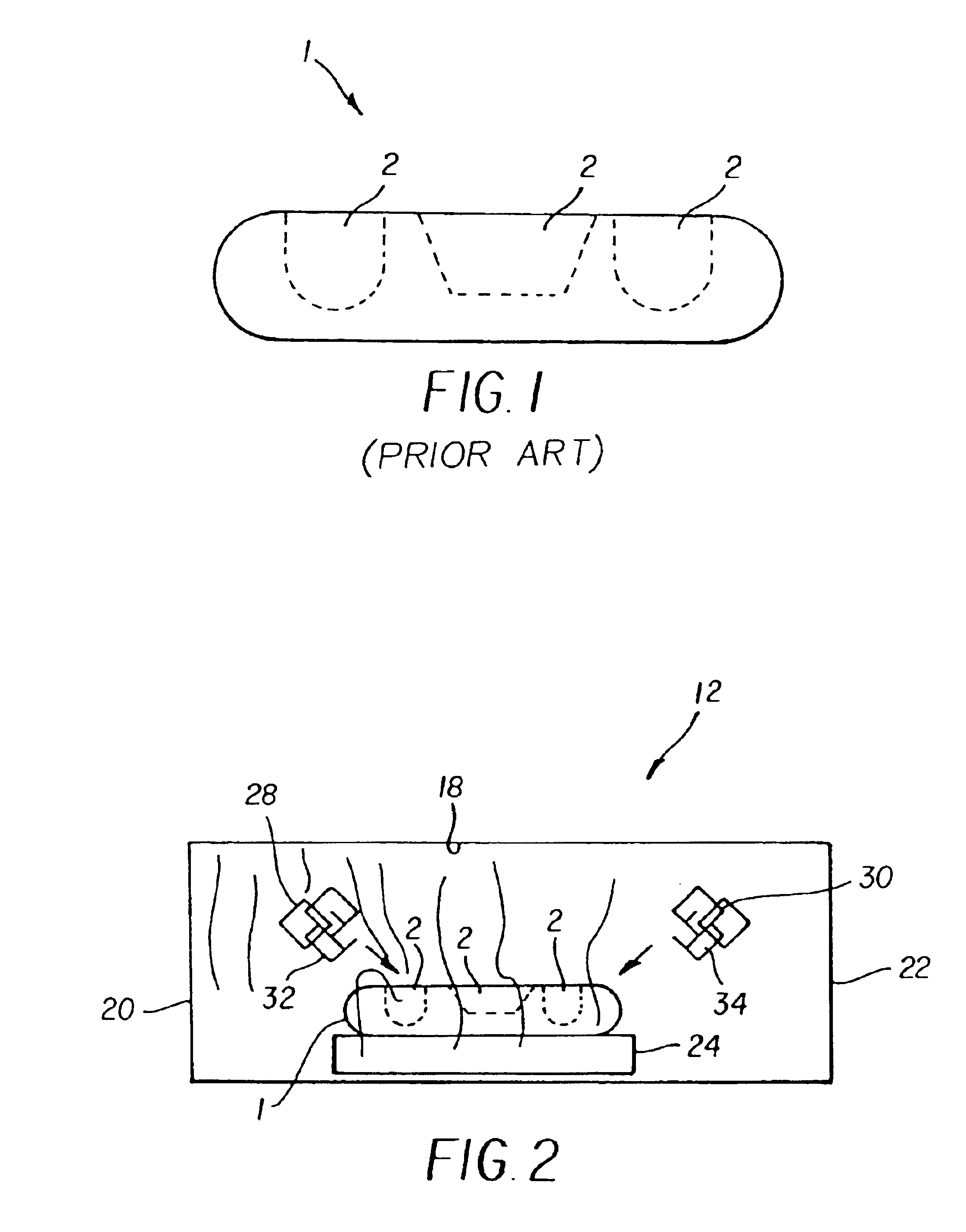Method for cleaning charged particles from an object
a technology for cleaning particles and objects, applied in the direction of cleaning using liquids, drying machines with progressive movements, furnaces, etc., can solve the problems of difficult dislodging of particles using, accumulating dirt and other undesirable particles, recyclable cameras, etc., and achieves the effect of simple use and cost-effective construction and operation
- Summary
- Abstract
- Description
- Claims
- Application Information
AI Technical Summary
Benefits of technology
Problems solved by technology
Method used
Image
Examples
example 1
[0043]This example demonstrates that for the apparatus 10 of the invention, an air knife pressure of at least 20 psi yields extraordinary cleaning of both fibers and plastic contaminants from the object being cleaned.
[0044]Apparatus 10 (refer to FIGS. 2 and 3) of the invention for cleaning irregularly shaped features 2 of objects 1 was tested for electric field intensity and particle removal efficiency. A rough measure of the electric field intensity was made using an electrostatic fieldmeter, such as a Simco Hand-E-Stat™ meter. The test sequence consisted of first tribo charging the object 1 being cleaned, such as a camera body component, with a color (e.g., blue) cotton cloth, to approximately −2000 volts / cm. A piece of polystyrene is then scraped over the camera component, adding plastic shavings or skivings onto the generally irregular, undulating surface features 2, including, for instance, in the film wells and lens baffle. Using the Simco meter, the electric field intensity i...
example 2
[0050]This example demonstrates that consistent cleaning efficiency, not possible in conventional cleaners, is provided by the positive pressurization requirement in apparatus 10 of the invention.
[0051]Referring to Table 2, in order to determine if the pressurization system was needed, the test was repeated with the fan shut off. While no air was forced through the filter and screen, the downward direction resulting from the combination of the air knife pressures and the exhaust slots drew air though the fan and filter, into the chamber:
[0052]
TABLE IItop fan offair curtainE-field beforeE-field afterfiberplasticpsikv / cm.kv / cm.removalremoval82.040.181182.960.192182.030.1511122.430.1631122.320.1241122.170.1232153.320.1343151.880.0742152.850.1343202.260.0544201.850.0554202.070.0443242.150.0444242.020.0333242.510.0623282.540.0254282.320.0754282.780.0445
[0053]According to Table II, the results indicate that without the pressurization (see Table I), the cleaning efficiency is erratic, part...
example 3
[0054]In this example it is demonstrated that cleaning efficiency of apparatus 10 can be easily optimized as a function of enclosure pressure.
[0055]Referring to Table III, tests were performed to determine the optimum cleaning efficiency with varying chamber pressures. To change the amount of air directed downwardly into the cleaning chamber or partial enclosure 12, two perforated plates were selected that restrict the air flow more than the initial perforated plate. The original perforated plate allowed greater than 50% of the filtered air to pass through into the chamber.
[0056]According to Table III, the first perforated plate to be tested restricts the air flow to 26% of the fan capacity:
[0057]
TABLE IIIairknifeE-field beforeE-field afterrankrankpressurekv / cm.kv / cm.fibersplastic122.561.2811cleaned emitter points122.630.2631152.580.3853152.180.3231152.360.3833203.170.2633252.1 0.2432252.570.2844301.990.2855
[0058]According to Table IV below, a second perforated plate tested restrict...
PUM
| Property | Measurement | Unit |
|---|---|---|
| Electric potential / voltage | aaaaa | aaaaa |
| Length | aaaaa | aaaaa |
| Length | aaaaa | aaaaa |
Abstract
Description
Claims
Application Information
 Login to View More
Login to View More - R&D
- Intellectual Property
- Life Sciences
- Materials
- Tech Scout
- Unparalleled Data Quality
- Higher Quality Content
- 60% Fewer Hallucinations
Browse by: Latest US Patents, China's latest patents, Technical Efficacy Thesaurus, Application Domain, Technology Topic, Popular Technical Reports.
© 2025 PatSnap. All rights reserved.Legal|Privacy policy|Modern Slavery Act Transparency Statement|Sitemap|About US| Contact US: help@patsnap.com



